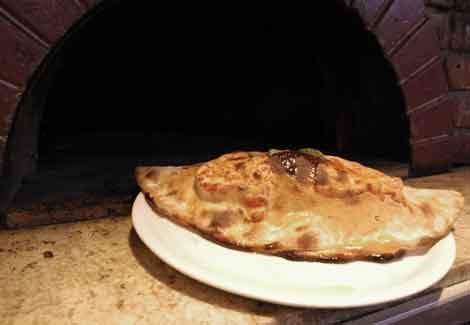Pizza's first cousin, the calzone, is essentially an inside out, folded
over pizza.

Named
for the style of baggy pant leg worn by 18th century Neapolitan
gentlemen, the calzone has long been considered a classic form of pizza.
Wearing its crust on the outside and harboring a
luscious filling on the inside, the calzone is a treat for crust lovers.
There's nothing quite like cutting into the crisp, golden brown crust of
a perfectly baked calzone and experiencing that first whiff of steamy
goodness, while the rich molten filling oozes out. On the other hand,
diving into a pale, soggy, undercooked calzone with a filling that is
still cold at the center has nothing poetic about it. All too often,
most calzones are not well thought out both in the filling and the
production departments.
Calzones can be great for leftover bits of ingredients. In terms of
calzones, less is truly more. Simple combinations really do work best.
The other necessity for a truly fabulous calzone is an evenly hot oven.
Calzones take longer to cook than pizza and require a lower temperature
in order to crisp the crust and to penetrate the filling.
The beauty of calzones is that they can be produced
in nearly any oven.
The problem with calzones is that
they take time to bake and can take up valuable oven space.
Many operators prepare individual ones ahead of time and reheat them for
the service time crunch. Other traditional, old-time pizza joints that
bake theirs to order usually have a 30-minute cooking time. Some
operators simply don't offer calzones during mealtime rushes because
they take too much time to produce and to bake.
Experience shows that when it comes to calzone production, small is
beautiful. Large calzones are difficult to handle, they can leak in the
oven and often burn on the outside before the filling is cooked inside.
Smaller 8- to 12-inch calzones work best in any type of oven. They
generally take about 15 to 20 minutes to cook at 400 F and don't take
that much longer to put together than a pizza.
Most calzones are made in the traditional half-moon shape that is
achieved by rolling or pressing out the dough ball into a circle. The
filling is mounded into the bottom half of the circle and the top part
is folded over and crimped by hand or with a fork.
Dough
Try not to roll or sheet the dough out less than one quarter of an inch
thick and make sure the dough is even -- thin spots can lead to messy
oven leaks. To seal the edges of the calzone, use the tines of a fork or
crimp the edges together as you would for a pie crust and trim any
excess dough off with a pizza cutter. Some operators like to brush the
tops of their calzones with an egg white wash to make them shiny, while
other operators prefer to brush lightly with olive oil before baking.
Olive oil promotes browning and crispiness. When the calzone comes out
of the oven, the top should be lightly brushed with olive oil again.
This will add sheen and flavor to the crust.
Cheeses
Ricotta is the most traditional and popular base filling for calzones.
Thick, creamy ricotta that contains less moisture works best. When
working with softer, wetter ricotta, try making a calzone base to which
eggs are added. Not only will the filling taste better, but it will not
ooze out and won't make the calzone as soggy. The best formula calls for
one whole egg per quart of ricotta. Additional seasonings like Parmesan
cheese, parsley, salt and pepper make a wonderful calzone base, which
can also double as a pasta and lasagna filling. If using mozzarella or
provolone, shredded or diced works best in fillings. Grated cheeses such
as Parmesan and Romano help create a depth of flavor to your calzone
cheese base blend.
Fillings
Par-cooked fillings work best, because it generally takes too much time
for heat to penetrate and cook them from the raw state. Meat fillings
like sausage, bacon, chicken or ground beef should all be cooked through
before using in a filling. Larger items like meatballs and sausage
should be broken up, ham should be sliced thin, chicken works best diced,
and pepperoni and salami work fine sliced. Vegetables should also be
pre-cooked and cut into smaller pieces. If you want to add sauce to the
filling, keep it to a minimum.
Putting it all together
Roll out a small dough ball (about 8 ounces) into a round of one quarter
inch thickness.
Place a small handful of mozzarella on the lower half and about three
quarters of a cup of filling, or combination of filling. For three
fillings, use 1/4 cup each.
Mound 1/2 to 1 cup of ricotta over all. Season with salt, pepper and a
pinch of Parmesan cheese (unless those seasonings are already present in
your ricotta base).
Fold the top half of the dough over the bottom and crimp the edges
together. Carefully shift the calzone onto a peel and lightly brush the
top with olive oil.
Allow to bake in a 400 F oven (at least 15 minutes) until golden brown.
Remove the calzone from the oven, lightly brush with some more olive oil,
sprinkle with grated Parmesan and serve with a side of warm marinara
sauce.